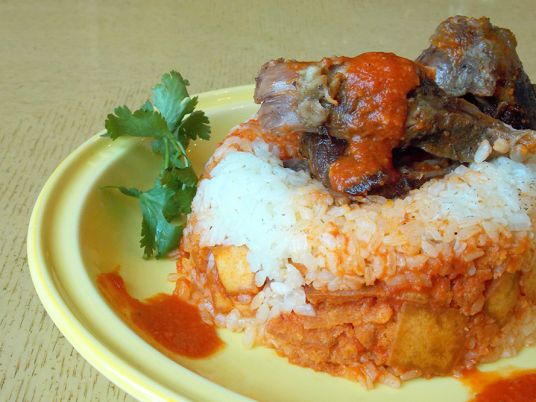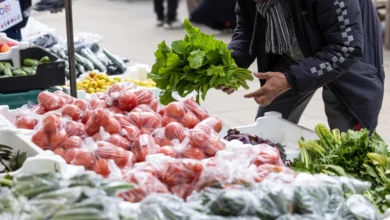
So Eid al-Adha has arrived once more, along with the many animals prepared for slaughter and the resulting abundance of meat. Egyptians have come to know the feast as a time for families to gather round the dining table, plates piled with traditional dishes.
Most Egyptian mothers will know what’s expected of them in this department, turning out the standard fattah dishes that everyone loves. But a glance around the Muslim world presents a surprising range of options, some of them quite delicious.
The dishes often make use of local ingredients specific to each nation. As a consequence, in different countries, people are found celebrating the same feast but with food that has very distinct flavors.
Egypt's traditional dish at Eid al-Adha is fattah
Egypt’s traditional Eid dish is, of course, fattah bel mozah, consisting of rice and fried bread and a large slab of mutton served on top. There are already variations in the way that Egyptians prepare their fattah. Some people drizzle vinegar over it, while others drown the dish in a dense butter-based tomato sauce.
Looking around the Muslim world, one finds the essentials are not much different from this basic Egyptian combination: lumps of meat plus some kind of carbohydrate. But the difference – and the magic – is in the detail, including the range of sauces, herbs and spices, along with a variety of cooking methods.
Grilled mutton, a classic Eid dish cooked in a time-honored way
Perhaps the signature cooking method is grilling, a technique common everywhere from Morocco to Bangladesh, although techniques vary from place to place. Perhaps the most popular is grilling lumps of meat on skewers along with various vegetables. Kebabs are very popular at Eid, and mutton is the perfect meat for this cooking method, the fat adding greatly to the flavor.
North Africa – also known as the Arabian Maghreb – is the birthplace of the tagine, a dish that is oven-baked in a clay pot, a tradition passed down from the Berbers. Naturally, the tagine is a staple Eid food in the Maghreb region, and it is made in a variety of ways.
It certainly falls into that category of very dense, fatty food that is traditionally consumed during Eid. While in Egypt, rice is the king of all carbs, in the Maghreb, couscous reigns, serving the same purpose as rice. While couscous is normally associated with North Africa, there is no reason not to introduce it to an Egyptian meal as an alternative to the standard bed of rice.
North Africa's favorite Eid dish, mrouzia, is a mix of sweet and savory
The most popular Eid dish in North Africa is mrouzia, a sweet and salty meat tagine, made with the characteristic ras el hanout blend of spices that is native to that region. It is integral to North African cuisine as garam masala is to Indian cuisine.
Mrouzia traditionally consists of Eid mutton cooked with vegetables, honey, cinnamon and almonds and served with couscous, which is cooked separately. Such a combination may be unusual for the Egyptian palate, since we like to keep our sweets separate from our savories. That said, it keeps a great many North Africans happy, and there’s no doubt it grows on you.
Biryani is an Indian delight, originating in Persia
Muslims in India and Pakistan prepare Eid dishes laden with spices, giving the food a taste that’s very different from the simple Egyptian lamb fattah. The Indian version of fattah is biryani, a basmati rice dish that originates from Persia. It consists of meat and rice cooked separately at first, then combined into one entity for the final stage of cooking.
The dish is traditionally slow cooked, which makes for some tender mutton, especially when made with Eid meat fresh from the slaughter. In India, the spices used vary from region to region, and this is where things could get fun for Egyptians. Attempting such a dish allows for some experimentation on the spices used – assisted ideally by a good recipe book or online source. Egyptian cooking tends to rely heavily on simplicity, but there’s no harm in spicing things up once in a while.
Another dish that is native to the Indo-Pakistani region is haleem, which is basically slow-cooked meat with lentils or bulgur. The bones are removed from the meat and it is left to cook in a butter-based sauce that is quite delicious. No Eid table in that region would be complete without haleem.
Lebanese fattah with yogurt, lemon, pine nuts and chickpeas
While Egyptians may not be so familiar with North African or Indian cuisine, they tend to know quite a few Lebanese and Syrian dishes. What sets the Levant’s cuisine apart is how much lighter it is, with olive oil being a staple ingredient instead of the Egyptian staple, ghee.
It also tends to involve a lot of ingredients rarely found in Egypt. The Lebanese have their own version of fattah, which has all the basics of the Egyptian dish, but also boiled chickpeas, pine nuts, carrots, celery, yoghurt, mint and sometimes lemon juice. The differences are clear, and this dish is perfect for those wishing to enjoy Eid without expanding their waistline.
Syrian shakareya, consisting of mutton cooked in a sour-milk sauce
In Syria, a traditional Eid food is shakereyah, which is like Egyptian fattah but with some interesting twists, notably the inclusion of sour milk. The milk cooks for a while on a low heat until it boils, at which point the mutton — which has been cooked separately — is added to the milk and stirred. The meat dish is then served with rice, but in a bowl, swimming in the milky juice.
The Saudi Arabian dish of kabsa — a true Eid treat
Across the Red Sea in Saudi Arabia, the main event is kabsa, which is actually a staple food of the country. The dish consists of a bed of spiced rice that is colored with food colorings, served with mutton that is cooked separately. For the authentic experience of kabsa, try eating it with your bare hands!




